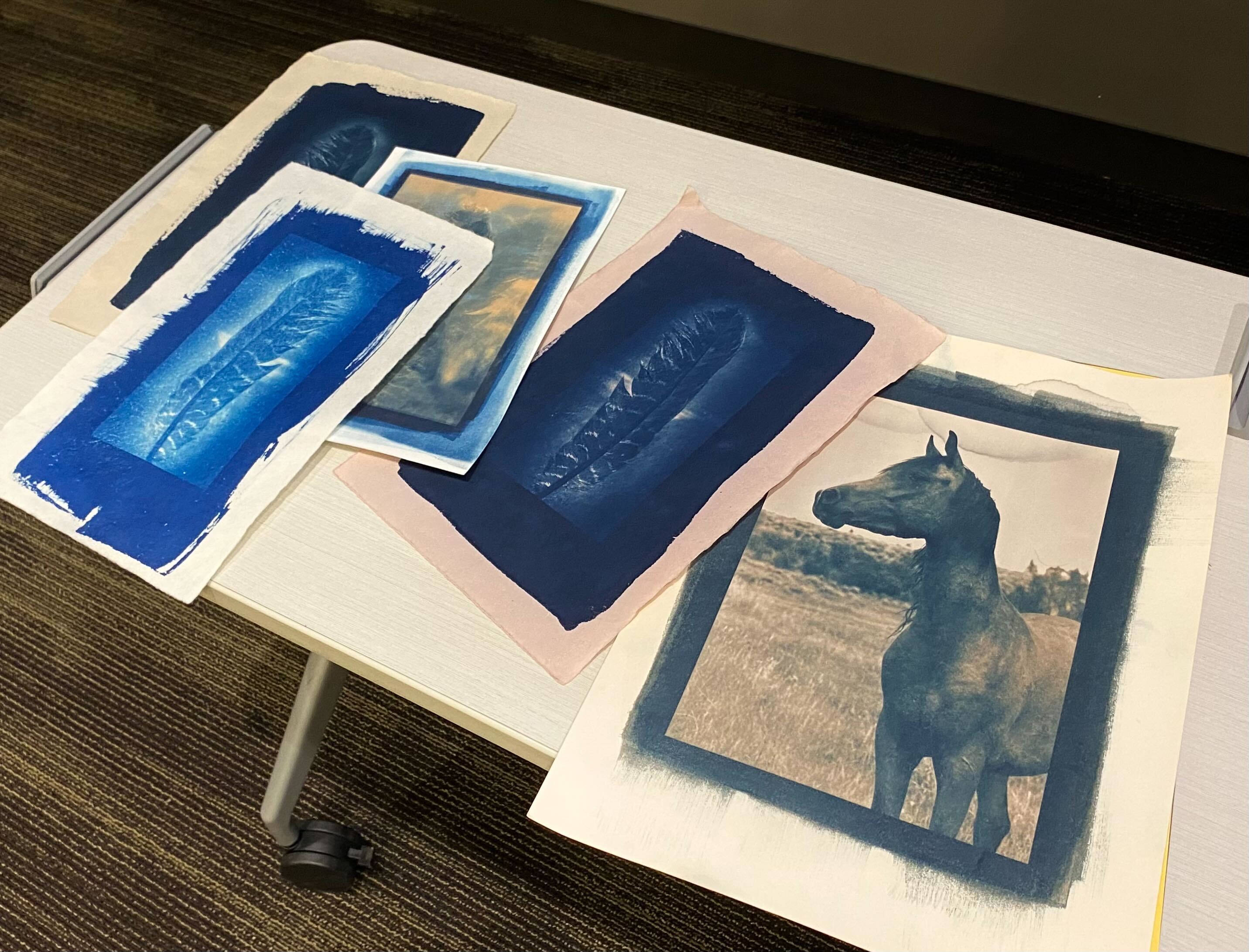In the traditional practice of photography, the darkroom is a sacred space.
Designed to accommodate the light-sensitive process of developing a photograph, darkrooms are nurseries for snapshots in time. Here, the artist’s vision is translated, transfigured, into a tangible image. It’s often overlooked, though, that this key phase in the life of a photograph is deeply indebted to the chemistry of pigments and of light.
In honor of National Chemistry Week, the Stanford Department of Chemistry held a two-day workshop on Oct. 24–25, in collaboration with the Department of Art & Art History. Themed “Picture Perfect Chemistry,” the event kicked off on Thursday with a talk by Sommer Wood, manager of Stanford’s Photography Lab, who traced the role chemistry plays in the history and development of photographic processes. Friday’s hands-on workshop then brought this into practice, allowing students, faculty and alumni to experiment with cyanotypes — a mode of early photographic printing.
“The [chemistry department] thought it would be a good idea to pair up with our department and have a subject expert on chemistry in photography talk to the students,” Wood said.
Owing to her undergraduate and graduate training as a photographer, Wood said her approach to chemistry has little to do with the technical nitty gritty of the periodic table or the mathematical minutiae of a stoichiometric calculation.
Instead, her familiarity with chemistry stems from creative expression — from years of experimenting with photographic techniques that employ different chemical principles, blurring the line between studio and laboratory. As a photographer, she noted, it’s vital to understand how different chemical processes produce different aesthetic results.
But how did these scientific techniques come to be applied in photography? To answer this, Wood laid out an expansive chronology of photographic history, from the camera obscura — a precursor to the modern camera that has been described as early as the 5th century BCE — to the discovery of silver nitrate and silver halides as light-sensitive materials by 19th-century photographers.
At each step, Wood said, advancements in photography were driven by chemical methods.
Using the petroleum-based substance bitumen, for example, the inventor Nicéphore Niépce developed the first permanent image in the 1820s: a view from outside his window in eastern France. He termed his technique “heliography,” where helios refers to the light exposure required as part of the procedure. Louis Daguerre would build on Niépce’s pioneering work in the following decades, using silver iodide to capture images in a process aptly named the daguerreotype.
Wood also situated these early photographs in conversation with modern aesthetics. She explained that the history of photography might explain why Instagram photos are square in format or why popular color filters follow certain patterns of hues and tones. One of Instagram’s founders had been influenced by the square format of Polaroids, she said, and modern color filters often seek to mimic the organic “chemical” effects of a vintage photo — a testament to the influence of older photographic methods in modern visual culture.
Jennifer Schwartz Poehlmann Ph.D. ’08, a senior lecturer in chemistry, said photography exemplifies the ubiquitous presence of chemistry in day-to-day life.
“We don’t realize it a lot of times — we all take digital imaging for granted these days,” Poehlmann said. “[This event] is a fun way to explore how chemistry is embedded in the history of things that we use on a daily basis.”
In Friday’s cyanotype workshop, participants performed their own “chemical experiments” in producing photographic images. Attendees were instructed to press botanical materials — leaves, branches, flowers — onto paper prepared with iron-based solutions. In doing so, they created impressions of the plants against a field of rich Prussian blue, formed when iron compounds on the paper are exposed to ultraviolet rays from the Sun.
“When I teach, I try to convince students that chemistry is really important and relevant in everyday life, and I think doing activities like this really helps people understand that,” said workshop volunteer Shoshana Williams, a fifth-year Ph.D. candidate in chemistry. “Specifically, dyes are such a great way to get acquainted with chemistry because you can see them with your own eyes. You don’t need any specialized equipment to understand that there are cool chemical transitions happening.”
Indeed, Niépce, writing in the 19th century, described the chemical reactions behind a developing photograph as “magical.”
“I think that anyone who has the opportunity to see a photograph develop in the darkroom shares the sentiment that it feels magical,” Wood said in an interview with The Daily. “A photograph is also something that can be quite personal, and seeing this object that you’ve worked so hard to capture develop in the darkroom through that chemical process — the reward of that makes it even stronger.”
For students interested in exploring photography as an art form, Wood recommended several art practice courses at Stanford, including ARTSTUDI 171: “Introduction to Photography,” ARTSTUDI 170: “Light and Shadow” and ARTSTUDI 173A: “Introductory Photography — Blue.”
“Most of the students who come through the art department are not art majors, so we’re already collaborating with students all over the university,” Wood said. “It’s great to be able to [show] how the things they’re studying come to life in the darkroom.”
